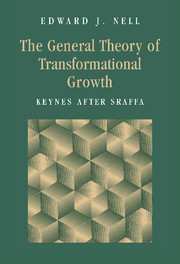Book contents
- Frontmatter
- Contents
- Preface
- Acknowledgments
- Part I History or equilibrium?
- Part II Method and approach: the active mind
- Part III Money and the Golden Rule
- PART IV The wage-profit trade-off
- 7 The Classical system: the Golden Rule, labor, and the wage-profit trade-off
- 8 The Classical system: gravitation and market adjustment
- 9 Cycles and growth: market adjustment in Craft conditions
- Part V Investment and Mass Production
- Part VI Money and fluctuations in the modern economy
- Conclusions
- Bibliography
- Index
8 - The Classical system: gravitation and market adjustment
Published online by Cambridge University Press: 21 January 2010
- Frontmatter
- Contents
- Preface
- Acknowledgments
- Part I History or equilibrium?
- Part II Method and approach: the active mind
- Part III Money and the Golden Rule
- PART IV The wage-profit trade-off
- 7 The Classical system: the Golden Rule, labor, and the wage-profit trade-off
- 8 The Classical system: gravitation and market adjustment
- 9 Cycles and growth: market adjustment in Craft conditions
- Part V Investment and Mass Production
- Part VI Money and fluctuations in the modern economy
- Conclusions
- Bibliography
- Index
Summary
None of the elements in the Classical equations represents a directly observable entity. The coefficients, as usually interpreted, represent physical inputs for “best-practice” techniques (which at most only a few firms yet use). Data are actually collected as costs, that is, in monetary terms, not in physical terms. The products are likewise idealized and defined in physical terms, whereas output data are also mostly collected as revenue. Neither firms nor households, nor any other decisionmakers appear. Prices are uniform – the “law of one price” is assumed – and prices are expressed in barter terms; rates of profit and wages are similarly smoothed out and hold in barter value. No trace of the unruly market or the hurly-burly of actual competition can be found. Nor could there be, for the Classical equations do not represent behavior at all. They portray, in simplified and idealized form, the essential structure of the capitalist system, the core relationships between wages, prices and profits, on the one hand, and consumption, quantities, and growth on the other.
Yet this poses an epistemological problem. If all our empirical data come from the market, while the Classical equations are independent of the market, how can we verify that those equations correctly describe the core relationships of the economy? An answer was supplied by Smith and Ricardo: market prices and other market variables “gravitate” toward, or around, the corresponding “natural” prices or other variables, where “natural” values are those determined by the Classical structural equations.
- Type
- Chapter
- Information
- The General Theory of Transformational GrowthKeynes after Sraffa, pp. 360 - 409Publisher: Cambridge University PressPrint publication year: 1998



